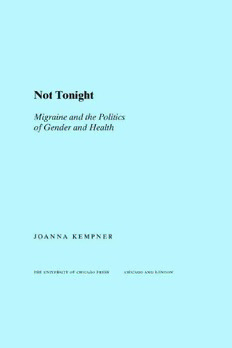
Not Tonight: Migraine and the Politics of Gender and Health PDF
Preview Not Tonight: Migraine and the Politics of Gender and Health
Not Tonight Not Tonight Migraine and the Politics of Gender and Health joanna kempner the university of chicago press chicago and london joanna kempner is assistant professor of sociology and an affiliate of the Institute for Health, Health Care Policy, and Aging Research at Rutgers University. The University of Chicago Press, Chicago 60637 The University of Chicago Press, Ltd., London © 2014 by The University of Chicago All rights reserved. Published 2014. Printed in the United States of America 23 22 21 20 19 18 17 16 15 14 1 2 3 4 5 isbn-13: 978-0-226-17901-8 (cloth) isbn-13: 978-0-226-17915-5 (paper) isbn-13: 978-0-226-17929-2 (e-book) doi: 10.7208/chicago/9780226179292.001.0001 Library of Congress Cataloging-in-Publication Data Kempner, Joanna Leslie, author. Not tonight : migraine and the politics of gender and health / Joanna Kempner. pages cm Includes bibliographical references and index. isbn 978-0-226-17901-8 (cloth : alk. paper) — isbn 978-0-226-17915-5 (pbk. : alk. paper) — isbn 978-0-226-17929-2 (e-book) 1. Migraine. 2. Migraine—Social aspects. 3. Headache— Social aspects. I. Title. rc392.k45 2014 616.8'4912—dc23 2014004075 a This paper meets the requirements of ansi/niso z39.48–1992 (Permanence of Paper). to my parents Were headaches known in the Age of Gold; or, when the millennium shall prevail, will they cease to be? Certain it is, that in any state where there are secrets to conceal or pangs to dissemble, this convenient malady could no more be dispensed with than the most necessary article of attire. How could society possibly go on without the trite but inexhaustible excuse that—better than any soft answer—turns away wrath, and, for a while, at least, closes the mouth of the accuser, so that the accused, whether inno- cent or guilty, have time to breathe and brace themselves for the question, if it must needs ensue? There are people, I believe, who discourse quite eloquently on the advantages of gout; surely as many could be found ready to cry Vive la migraine! george a. lawrence, Harper’s New Monthly Magazine, 1870 For the person in pain, so incontestably and unnegotiably present is it that “having pain” may come to be thought of as the most vibrant example of what it is to “have certainty,” while for the other person it is so elusive that “hearing about pain” may exist as the primary model of what it is “to have doubt.” elaine scarry, The Body in Pain, 1985 Contents List of Illustrations viii Preface ix Acknowledgments xvii List of Abbreviations xxi Introduction 1 chapter 1. All in Her Mind 24 chapter 2. All in Her Brain 51 chapter 3. Embracing the Migraine Brain 75 chapter 4. Gendering the Migraine Market 106 chapter 5. Men in Pain 134 Conclusion 158 Appendix A—International Classification of Headache Disorders 171 Appendix B—Methods 175 Notes 185 Bibliography 207 Index 229 Illustrations Figure I.1 2007 NIH funding per DALY (Disability-Adjusted Life Years) / 9 Figure I.2 New Yorker cartoon / 19 Figure 1.1 Wolff’s experiment / 36 Figure 1.2 “Headaches Are a Luxury” / 39 Figure 1.3 1960s pharmaceutical advertisement / 42 Figure 4.1a–f Imitrex advertisement / 124 Figure 4.2 Zomig advertisement “Escape from Migraine” / 127 Figure 5.1 “Women with Cluster Headache” / 144 Figure 5.2 Persistence of cluster headache profile in textbooks / 148 Figure 5.3 Percent of textbooks that support or reject cluster profile / 149 Figure 5.4 Typical representation of a cluster man / 150 Preface My headaches began when I was five years old. A pediatrician diag- nosed me with a “type A personality” and assured my parents that nothing could be done. My mother, herself debilitated by migraine, re- jected his diagnosis. Thus began a long and frustrating quest for headache relief. By high school graduation, we had consulted at least a dozen or more health care providers, a group that included several general practi- tioners, a well-respected headache specialist, his clinic’s psychiatrist, an acupuncturist, a massage therapist, an herbalist, as well as several chiro- practors and physical therapists. Each relied on different diagnostic pro- cedures, which were frustrating at best (a misread CAT scan indicated a rather alarming enlarged pituitary gland) and sometimes offensive (how of- ten do patients get asked explicitly or otherwise whether their pain is real? Since pain is a sensation, isn’t it always real?). Each had new treatments for me to try—anti-inflammatories and antidepressants, beta-blockers, muscle relaxants, painkillers, acupuncture, teas, diets, and homeopathic pills. I had needles embedded in my ears. I learned to meditate. I laid with my neck in traction. And I wished that one of my doctors would find a clear-cut biological abnormality that could explain my pain. A tumor might be removed, I reasoned. In college, I managed these headaches with a firm commitment to de- nial and a cocktail of prescription painkillers and muscle relaxants. The medications never relieved the pain, but they helped me sleep or, some- times, just laugh it off. Needless to say, plans were canceled and classes missed. Eventually, I learned that my headaches were migraines. Like so many other people with migraine (a disorder that experts always refer to in the singular), I would find myself vomiting in an emergency room, hoping that nobody would treat me like a drug addict who invents pain in
